Sir Gawain facts for kids
Quick facts for kids Sir Gawain |
|
|---|---|
| Matter of Britain character | |

Sir Gawaine the Son of Lot, King of Orkney, by Howard Pyle from The Story of King Arthur and His Knights (1903)
|
|
| Information | |
| Occupation | Knight of the Round Table |
| Title | Prince, Sir |
| Family | Various members of King Arthur's family
Le Morte d'Arthur: Lot and Morgause (parents); Agravain, Gaheris, Gareth and Mordred (brothers) |
| Spouse(s) | Ragnelle, Orguelleuse, Amurfina (in different stories) |
| Children | Various, including Gingalain |
| Relatives | King Arthur (uncle) |
| Religion | Christian |
| Origin | Orkney and/or Lothian |
| Weapon | Caliburn, others |
Gawain is a famous knight from the stories of King Arthur. He is King Arthur's nephew and a brave Knight of the Round Table. His story is told in many languages, like in the famous poem Sir Gawain and the Green Knight.
Gawain is often shown as one of King Arthur's best friends. He is a very important member of the Knights of the Round Table. His parents are King Lot and Arthur's sister, Morgause.
In early Welsh stories, Gawain is a strong and polite warrior. He is very loyal to his king and family. People know him as a friend to young knights. He also helps people who are poor or in trouble. He is sometimes called the "Maidens' Knight" because he rescues women. Gawain is also known for his healing skills. He might have special swords, like Caliburn. His mighty warhorse is named Gringolet. In later stories, he has superhuman strength. This strength is linked to the sun. He becomes an unbeatable swordsman around noon.
Understanding Gawain's Name
Gawain has different names in different languages. For example, in Welsh, he is called Gwalchmei. The word Gwalch means hawk. This was a common nickname in old Welsh poems. The meaning of mei is not fully clear. Some people think it means the month of May. So, his name could mean "Hawk of May."
Gawain's Adventures and Role
Stories about Gawain began to appear outside Wales in the 1100s. A writer named Geoffrey of Monmouth helped make Gawain famous. He wrote about Gawain in his book Historia Regum Britanniae around 1136.
In Geoffrey's story, Gawain (called Gualguanus) is the son of Arthur's sister, Anna. His father is King Lot, a prince and a key supporter of Arthur. Geoffrey says Gawain was twelve years old when Arthur fought a war with Norway. Gawain had also served the Pope in Rome.
Gawain later became a main leader in Arthur's war against the Romans. He even started this big conflict himself. He killed a Roman messenger who had insulted him and Arthur. Geoffrey shows Gawain as an amazing warrior. He even calls him one of the best warriors ever. Sadly, Gawain is later killed by his brother Mordred (Modredus). This happens during a sea landing that goes wrong. Geoffrey's book was very popular. It was turned into many languages.
See also
 In Spanish: Gawain para niños
In Spanish: Gawain para niños
- King Arthur's family
Images for kids
-
Now you have released me from the spell completely. William Henry Margetson's illustration for Hero-Myths and Legends of the British Race (1910)
-
Sir Gawain bends over the exhausted Maid Avoraine in concern after she has proved her love by running after his horse for two days. John Everett Millais' and Joseph Swain's wood engraving illustration for Robert Williams Buchanan's poem "Maid Avoraine" published in Once a Week magazine in 1862
-
John Tenniel's illustration for "The Song of Courtesy", George Meredith's take on Gawain and the Loathly Lady published in Once a Week magazine in 1859
-
Nevertheless You, O Sir Gauwaine, Lie. Florence Harrison's illustration for Early Poems of William Morris (1914)
-
Gawain unwittingly fights Yvain in the Garrett MS. No. 125 manuscript of Chrétien's Knight of the Lion (c. 1295)
-
The Passing of Sir Gawaine, Howard Pyle's illustration from The Story of the Grail and the Passing of King Arthur (1910)
-
Parzivals Gawain in a capital relief at the Church of Saint-Pierre, Caen
-
Sir Gawaine finds the beautiful Lady, Howard Pyle's illustration from The Story of King Arthur and His Knights (1903)















